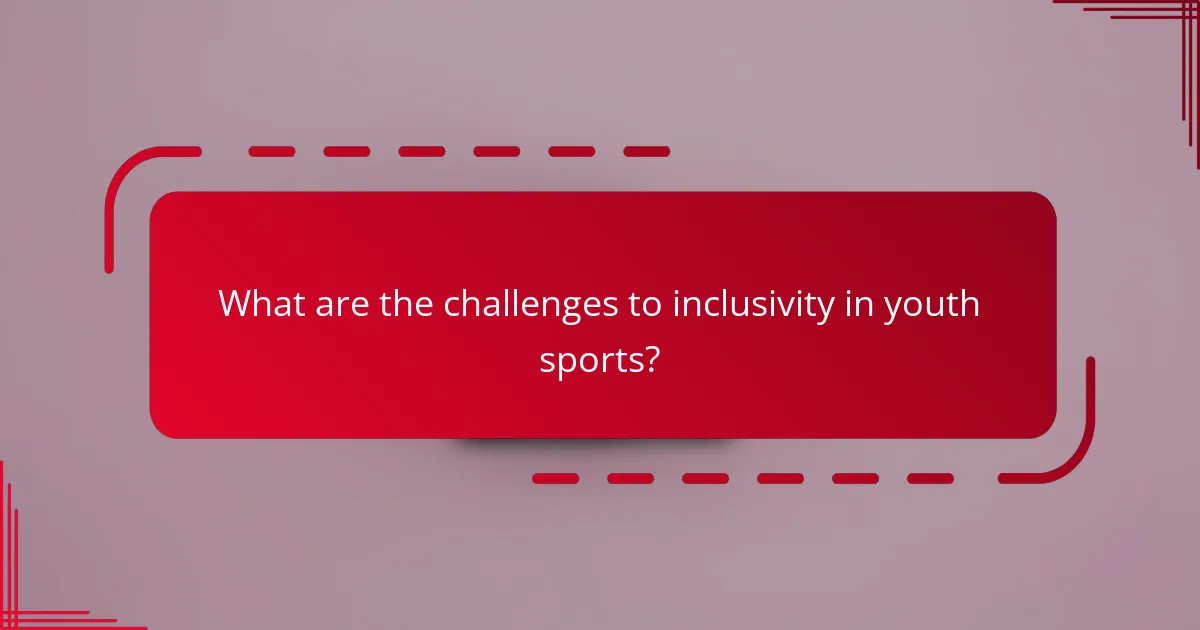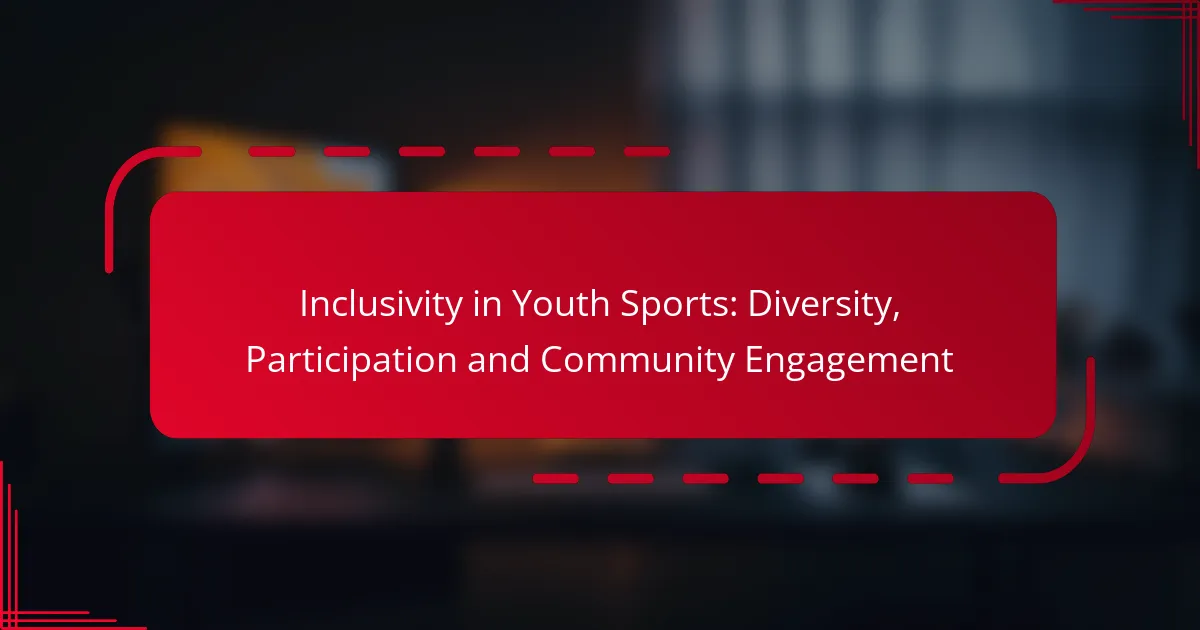Inclusivity in youth sports is essential for fostering a sense of belonging and community among young participants from diverse backgrounds. By implementing strategies that promote equitable access and engagement, sports programs can break down barriers and encourage participation from underrepresented groups. This not only enhances personal growth but also strengthens community ties through shared experiences and cooperation.

How can youth sports promote inclusivity in major US cities?
Youth sports can promote inclusivity in major US cities by implementing strategies that engage diverse communities, provide equitable access, and foster a welcoming environment for all participants. These initiatives help break down barriers and encourage participation from underrepresented groups.
Community outreach programs
Community outreach programs are essential for connecting with diverse populations and encouraging participation in youth sports. These programs can include partnerships with local schools, community centers, and non-profit organizations to identify and reach out to underrepresented youth.
Effective outreach might involve hosting free sports clinics, providing transportation assistance, or offering scholarships to cover registration fees. Engaging families and local leaders in these efforts can enhance trust and participation rates.
Inclusive coaching training
Inclusive coaching training equips coaches with the skills to create supportive and diverse environments for all athletes. This training should cover topics such as cultural competency, adaptive coaching techniques, and strategies for addressing bias in sports settings.
Coaches trained in inclusivity can better understand the unique challenges faced by athletes from various backgrounds, fostering a sense of belonging and encouraging participation. Regular workshops and certifications can help maintain high standards in coaching practices.
Diverse team compositions
Creating diverse team compositions is vital for promoting inclusivity in youth sports. Teams should reflect the demographics of their communities, allowing athletes to learn from each other’s experiences and backgrounds.
Encouraging mixed-gender teams, integrating athletes with disabilities, and ensuring representation from various ethnic and socioeconomic backgrounds can enhance team dynamics. This diversity not only enriches the sports experience but also prepares young athletes for a multicultural society.

What are the benefits of diversity in youth sports?
Diversity in youth sports fosters a more inclusive environment that enhances personal growth and community engagement. By bringing together individuals from various backgrounds, youth sports programs can promote understanding, cooperation, and a sense of belonging among participants.
Improved social skills
Participating in diverse youth sports teams helps young athletes develop essential social skills. They learn to communicate effectively with peers from different cultures and backgrounds, which can enhance their ability to navigate social situations both on and off the field.
For example, team members may need to collaborate on strategies or resolve conflicts, requiring them to practice active listening and empathy. These interactions can lead to stronger friendships and improved interpersonal relationships.
Enhanced teamwork
Diversity in youth sports encourages teamwork by combining varied perspectives and skills. When players from different backgrounds collaborate, they often bring unique strengths that can improve overall team performance.
Coaches can leverage this diversity by assigning roles that play to each athlete’s strengths, fostering a sense of unity and shared purpose. This not only enhances the team’s competitive edge but also teaches participants the value of cooperation and mutual respect.
Broader cultural understanding
Engaging in diverse youth sports exposes participants to a variety of cultural practices and values. This exposure helps young athletes develop a broader worldview and appreciation for differences, which is crucial in today’s interconnected society.
Programs can facilitate cultural exchange through activities such as sharing traditional games or celebrating various cultural events. These experiences not only enrich the sports experience but also promote inclusivity and respect among team members.

How can organizations increase participation in youth sports?
Organizations can increase participation in youth sports by implementing targeted strategies that address barriers to entry, such as financial constraints and accessibility issues. Fostering community engagement and collaboration with local entities can also enhance outreach and support for diverse youth populations.
Scholarship programs
Scholarship programs play a crucial role in making youth sports accessible to families facing financial challenges. By offering financial assistance, organizations can cover registration fees, equipment costs, and travel expenses, thereby removing economic barriers. For example, a local soccer club might provide scholarships that cover up to 100% of costs for qualifying families.
To effectively implement scholarship programs, organizations should establish clear eligibility criteria and promote these opportunities within the community. Partnering with local schools and community centers can help reach families who may benefit from such support.
Partnerships with schools
Forming partnerships with schools can significantly boost participation in youth sports by integrating sports programs into the educational system. Schools can serve as venues for practices and competitions, making it easier for students to engage in sports activities. Additionally, schools can help identify students who may benefit from sports participation, especially those from underrepresented backgrounds.
Organizations should collaborate with school administrators to create joint initiatives, such as after-school sports programs or physical education classes that emphasize inclusivity. This approach not only increases participation but also fosters a sense of community among students.
Accessible facilities
Ensuring that sports facilities are accessible is vital for increasing participation among diverse youth populations. Facilities should be equipped to accommodate individuals with disabilities and located in areas that are easily reachable by public transportation. For instance, a community sports center might offer wheelchair-accessible fields and provide transportation options for those in need.
Organizations should regularly assess their facilities for accessibility and make necessary improvements. Engaging with community members to gather feedback can help identify specific needs and enhance overall participation in youth sports.

What role does community engagement play in youth sports?
Community engagement is crucial in youth sports as it fosters participation, builds support, and enhances the overall experience for young athletes. By involving local stakeholders, organizations can create inclusive environments that encourage diversity and provide resources for all participants.
Building local support networks
Establishing local support networks is essential for the sustainability of youth sports programs. These networks can include parents, schools, local businesses, and community organizations that collaborate to provide resources, funding, and volunteers. For example, a local business might sponsor a team, helping to cover uniforms or equipment costs.
To build effective networks, consider hosting community meetings or events to gather input and foster relationships. Engaging with local leaders and influencers can also amplify outreach efforts and encourage broader participation.
Encouraging volunteerism
Volunteerism is a key component of community engagement in youth sports, as it provides essential support for programs while fostering a sense of ownership among community members. Encouraging parents and local residents to volunteer can lead to increased participation and a stronger sense of community. Simple roles such as coaching, organizing events, or assisting with logistics can make a significant impact.
To promote volunteerism, create clear opportunities for involvement and communicate the benefits of participation. Recognizing and appreciating volunteers through events or awards can also motivate others to get involved, creating a positive feedback loop that strengthens community ties.

What frameworks support inclusivity in youth sports?
Several frameworks promote inclusivity in youth sports, focusing on increasing participation and fostering diverse communities. These frameworks include national strategies and local government initiatives that aim to create equitable opportunities for all youth, regardless of background or ability.
National Youth Sports Strategy
The National Youth Sports Strategy (NYSS) provides a comprehensive framework to enhance youth sports participation across the United States. It emphasizes the importance of accessibility, inclusion, and community engagement, aiming to create a supportive environment for all young athletes.
Key components of the NYSS include partnerships with schools, non-profits, and local organizations to ensure diverse programming. The strategy encourages the development of inclusive policies that cater to various demographics, including underrepresented groups and individuals with disabilities.
Local government initiatives
Local governments play a crucial role in implementing initiatives that support inclusivity in youth sports. These initiatives often involve funding for community programs, the development of accessible facilities, and outreach efforts to engage diverse populations.
Examples include free or reduced-cost sports clinics, scholarships for low-income families, and targeted recruitment efforts in underserved areas. Local governments may also collaborate with schools and community organizations to create inclusive leagues and events that celebrate diversity.

What are the challenges to inclusivity in youth sports?
Inclusivity in youth sports faces several challenges, including socioeconomic barriers, lack of representation, and insufficient resources. These obstacles can hinder participation and limit opportunities for diverse groups, impacting overall community engagement.
Socioeconomic Barriers
Many families face financial constraints that prevent their children from participating in sports. Costs associated with registration fees, equipment, and travel can add up quickly, making it difficult for low-income families to enroll their children in organized sports programs.
To address these barriers, organizations can offer scholarships or sliding scale fees based on income. Community partnerships with local businesses can also help provide necessary funding or resources to support families in need.
Lack of Representation
A lack of diversity among coaches, administrators, and role models can discourage participation from underrepresented groups. When children do not see individuals who look like them in leadership positions, they may feel less inclined to join or remain in sports.
To improve representation, sports organizations should actively recruit diverse coaches and volunteers. Training programs that focus on cultural competency can also help create a more welcoming environment for all participants.
Insufficient Resources
Many youth sports programs struggle with limited funding and facilities, which can restrict access for various communities. Inadequate equipment, poorly maintained fields, or lack of transportation can deter participation and engagement.
To enhance resources, local governments and organizations should collaborate to secure funding and improve facilities. Establishing community sports days or events can also raise awareness and generate support for local programs.
